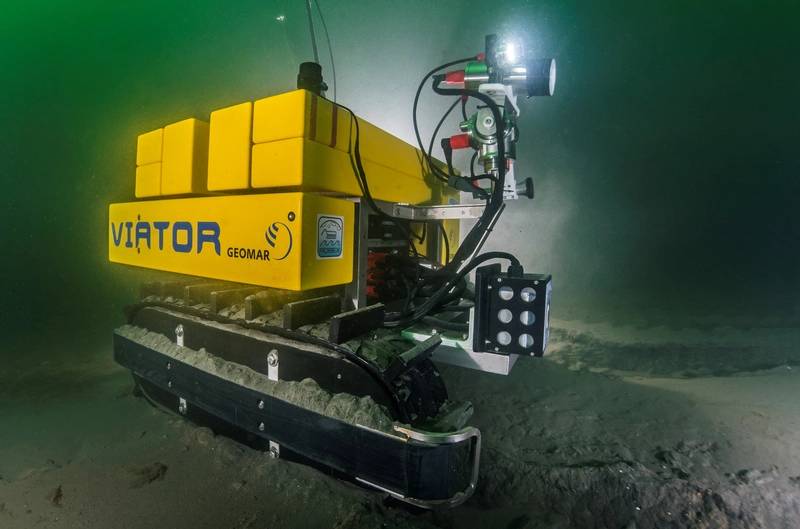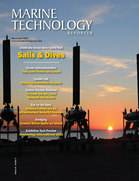Putting Power on the Seafloor is a Fuel Cell Future
Elaine Maslin
Two outfits, one in Germany and one in the US, are chasing a goal of supplying long-term subsea power in remote locations, via fuel cells, to users including oceanographic observatories to underwater vehicles. Elaine Maslin takes a look.
Long term operation of subsea equipment or instruments in remote locations poses something of a challenge. While battery technology has improved vastly, it’s still not sufficient for long term deployments.
For a decade or so, a number of projects have been working on ways to provide seafloor based remote power systems. This could be to power subsea production systems, resident remotely operated vehicles (ROVs) or autonomous underwater vehicles (AUVs) or to provide power to long-term remote ocean observatories.
Some are trialling the use of wave energy or ocean current converters. Nuclear options have also been assessed. However, two promising projects which propose fuel cells as a solution to this challenge have recently passed significant milestones.
One is a research project led by Germany’s GEOMAR Helmholtz Centre for Ocean Research Kiel, which recently tested fuel cell technology for use on a long-term seafloor observatory, where it could also be required to power robotics. The other is Teledyne’s Subsea Supercharger, which was recently put to the test over in Norway.
Powering up ocean observation
“The need for long-term observation systems on the seafloor has risen considerably and will continue to move into focus in the future”, says project manager Dr Sascha Flögel from GEOMAR. This could be to track environmental and climate trends or for exploration projects, where mobile, modular solutions would be beneficial. However, these are tending to be more power hungry, especially when energy-intensive robotic systems start to be added into the mix.
At the moment, power for underwater equipment or sensors tends to come from either batteries or cables. Cables are prohibitively costly for projects at any distance from the coast and no appropriate for systems only in place for a few years, while batteries are expensive and wasteful.
GEOMAR’s solution is a fuel cell, developed in partnership with the Centre for Solar Energy and Hydrogen Research, Ulm (ZSW), as part of the German Federal Ministry of Economics and Technology funded ARIM-FUEL project (ARIM stands for “Autonomous Robotic Sea-Floor Infrastructure for Bentho-Pelagic Monitoring”). It’s a proton exchange membrane (PEM) fuel cell, in which hydrogen and oxygen are fed to a polymer membrane electrolyte and platinum based electrodes, to generate power with heat and water as a by-product.
GEOMAR’s system comprises of 11 gas bottles of hydrogen and five bottles of oxygen and the fuel cell, developed by ZSW. “This gives us about 120 kW of power we can use for our monitoring efforts at the seafloor,” says Dr Flögel. In addition, the system has a 4 kW rechargeable battery, which the fuel cell charges. “If you wanted to generate the same amount of energy (using primary cells) you would need about 13,200 battery cells and that one charge costs about €20,000. It’s very cost intensive and has an environmental impact.” Most institutes use the same, although a few do use rechargeable batteries, he says. In comparison, to refill the fuel cell that GEOMAR has designed costs €1,250, a fifteenth of the cost, Dr Flögel says.
The system can deliver 150 W to 1kW output, a significant increase compared to previous solutions that draw their energy from primary cells or rechargeable batteries, says GEOMAR. This will cover many requirements, which include for long-term deep sea monitoring, but also, in future, recharging autonomous underwater vehicles (AUVs) and a seabed crawler, using an inductive seafloor recharging unit, says Dr Flögel. The system is currently rated to 1200 m depth, due to limitations of some of the pH sensors and buoyancy foam that are part of the sensor suite GEOMAR wants to use with it, says Dr Flögel. However, it’s targeting 3000 m by 2023-24.
A 48-hour test was carried out in the Baltic Sea in November last year, in cooperation with the Defense Technology Service Unit 71 of the German Army in Eckernförde. Further tests were run in February, and a further sea trial on RV Alkor, extending the test to 72 hours, is planned for March. These are mostly focused on stability and power management – efficiently recharging the battery in a way that limits switching the fuel cell on and off too much (something that’s not great for them).
The next steps are to look to use the new system as part of a series of robotic monitoring projects in the coming years. “The new energy supply for under water systems creates completely new possibilities for us to use the devices over longer periods of time”, concludes Dr Flögel.
 View inside the fuel cell containment. Photo: Finn K. Flögel.
View inside the fuel cell containment. Photo: Finn K. Flögel.
Teledyne tests its Supercharger
Over in Norway, working with Innova, Teledyne has put its Subsea Supercharger through validation testing at the Norwegian Center for Offshore Education, Tau Autonomy Centre, a subsea testing facility not far from Stavanger, Norway.
The system is configurable for more than 3 MWh of energy capacity, says Teledyne, and is designed to be deployed down to 1,000 metres water depth and provide up to 8 kW of steady state power.
Teledyne first unveiled the concept in 2018. It’s designed for energy storage requirements of at least 500 kWh or where cold temperatures are a possibility, says Dwight Warnock, Vice President, Teledyne Energy Systems, Inc. “This could be oil and gas fields, to provide an independent, stand-by energy source, but also as a research or observational platform in environmentally sensitive areas. “The Subsea Supercharger emits only water and a small amount of heat making it environmentally friendly and once the system has been recovered, no footprint remains. It can also provide power to a AUV recharging dock to support a persistent presence for performing surveys without the need for a support ship.”
The Subsea Supercharger is also a PEM fuel cell, comprising of three major components: “the fuel cell stack, the water management section, and the reactant (hydrogen and oxygen) supply section,” explains Warnock. “The oxygen and hydrogen gases are managed and supplied through an ejector-driven reactant (EDR) block [which eliminates the need for a mechanical pump]. The reactants are supplied to the EDR manifold where the gas flow creates the positive feedback needed to ensure consistent supply of reactants to the fuel cell with no moving parts.” It’s also a “load-following engine”, producing power to suit user requirements, without intervention, says Warnock, making it suitable for environments where routine access is limited.
The validation tests in Tau included putting the system to use powering a subsea hydraulic pumping unit developed by Innova. “The two systems were integrated and successfully deployed to a depth of 235 m (770 ft) where subsea control fluid was pumped to a pressure of 180 bar (2,600 psi) for 30 minutes, six times a day,” says Teledyne. “During the test, the Subsea Supercharger seamlessly transitioned from ‘Sleep-mode’ to ‘On’, in response to power demands from the pumping unit as it repeatedly cycled on and off,” says Teledyne.
“The testing at Tau demonstrated the Subsea Supercharger is capable of meeting real-world applications without the need for operator intervention,” says Warnock. “By integrating the system with a hydraulic pumping unit, this demonstration illustrated to the operators the feasibility of having a stand-by energy source for providing pressurized working fluid to oil fields for rapid intervention. The testing highlighted the flexibility of the Subsea Supercharger in terms of user load profiles by only supplying power as required. The demonstration also proved ease of deployment, set up and recovery. The entire system was loaded and deployed in a couple of hours without specialized equipment or training and recovered by a different boat crew with no technical representatives onboard.”
Another validation test is planned for this Spring, when the Subsea Supercharger will be integrated with an AUV charging dock to demonstrate untethered, long-duration AUV operations.
Alternative power sources
A number of other projects have been working to harness wave or ocean current energy, from the surface or at the seabed, to provide a consistent
power supply. Two will be getting their new systems wet alongside energy storage and management this year.
US-based C-Power is due to deploy its SeaRAY autonomous offshore power system (AOPS) at the U.S. Navy Wave Energy Test Site in Hawaii this year, for example. SeaRAY incorporates a wave energy converter and communications gateway at the surface, with power storage and delivery and communications at the seabed. The power delivery will be via a Halo subsea battery storage system from UK firm Verlume (previously known as EC-OG). A trial is set to demonstrate the ability to support resident underwater vehicles with power for recharging and communications.
Another wave energy technology company, UK-based Mocean Energy, is also working with Verlume. It’s due to test its Blue-X wave energy device with a Verlume battery offshore Orkney this year. This is also to demonstrate operations with an AUV, as part of a project with oil major Harbour Energy, the Net Zero Technology Centre and subsea inspection firm Modus.
US-based Ocean Power Technologies has been working in this space for a number of years, working with Premier Oil (now part of Harbour Energy) in the UK and Eni in Italy to trial its wave energy device in support of powering subsea wells at end of field life and supporting resident AUVs, respectively.
For those wanting somewhat more power, a more extreme example of potential power solution has been shared in Russia. There, Project Iceberg, presented back in 2017, proposed equipping seabed production facilities, in ice-bound areas, with nuclear reactors to provide power.
 GEOMAR’s Viator seabed crawler, which could soon get its power from a fuel cell. Photo from GEOMAR.
GEOMAR’s Viator seabed crawler, which could soon get its power from a fuel cell. Photo from GEOMAR.


 December 2025
December 2025



